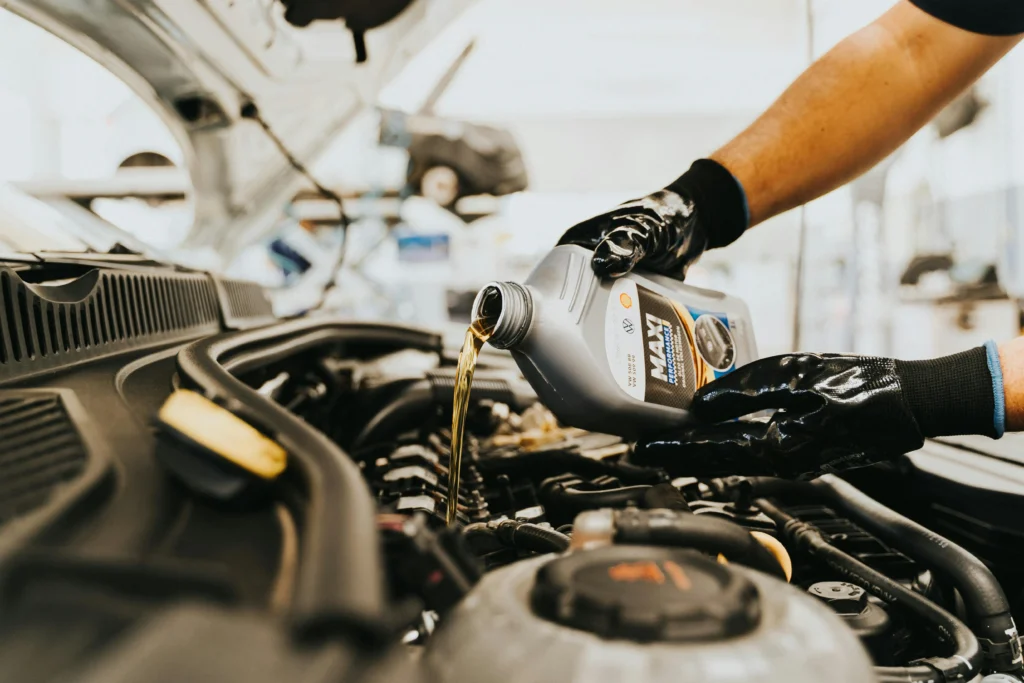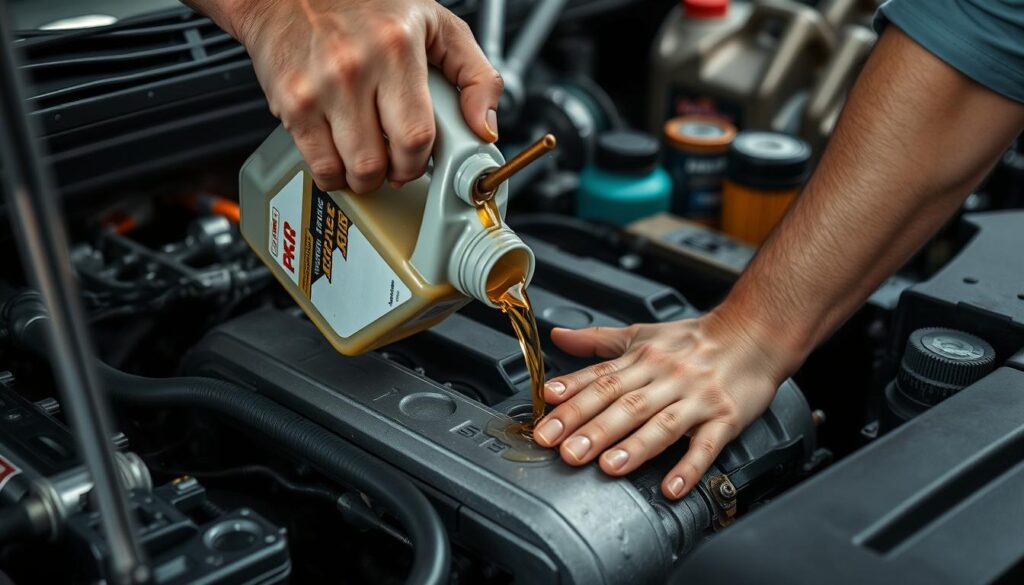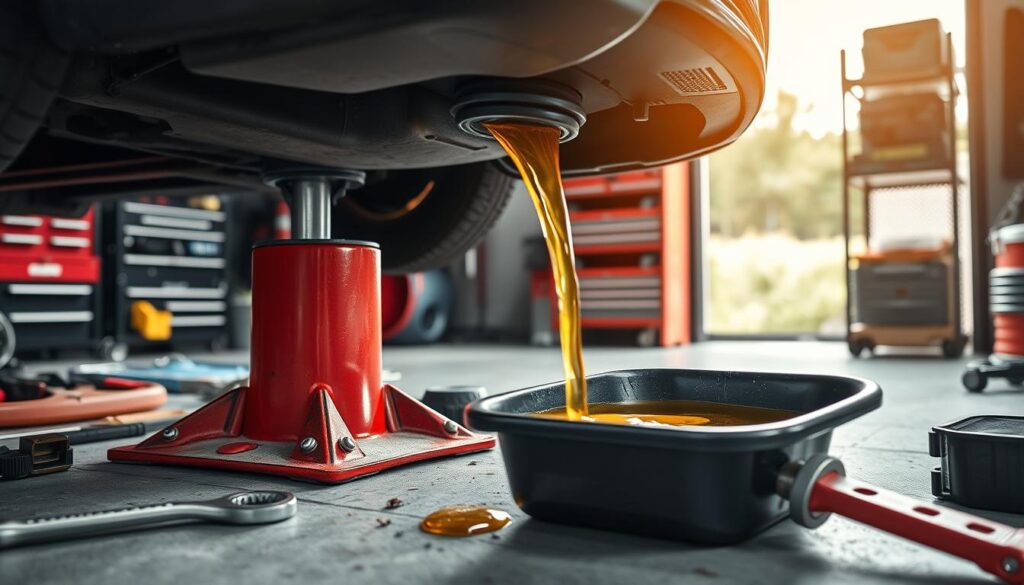As a busy professional, car maintenance can seem overwhelming. However, learning how to change car oil is a simple yet crucial task that can make your car last longer and run better. In this guide, we’ll show you the steps to safely and efficiently change car oil, helping you take care of your car and save money over time..
In This Guide
Understanding the Importance of Regular Oil Changes
Keeping your vehicle in top shape is key, and regular oil changes are a must. High-quality motor oil is vital for your car’s health. Without it, your car can suffer greatly.
How Oil Affects Engine Performance
Motor oil is crucial for your engine. It reduces friction, cools the engine, and prevents damage. If the oil gets old, your car’s fuel efficiency drops, emissions rise, and the engine might fail. Regular oil changes are essential for your car’s performance and life.
Signs Your Car Needs an Oil Change
- The oil appears dark, thick, or gritty
- You notice increased engine noise or vibration
- Your fuel economy has decreased significantly
- Your vehicle’s check engine light is illuminated
Benefits of DIY Oil Changes
Doing your own oil changes has many benefits. It saves money and helps you understand your car better. This way, you can spot problems early and take care of your vehicle more effectively. With the right tools and knowledge, DIY oil changes are a smart and affordable choice.
“Regular oil changes are the key to a long-lasting, high-performing engine.”
Essential Tools and Materials Needed
Changing your car’s oil is easy, but you need the right tools and materials. Having the right equipment makes the job smooth and successful. It doesn’t matter if you’re a pro or doing it for the first time.
To start, you’ll need these items:
- Wrench set (including a filter wrench)
- Oil drain pan
- Funnel
- New oil filter
- Enough new motor oil for a complete change (check your owner’s manual for the recommended amount and type)
- Gloves and protective eyewear
The right tools make the job easier and faster. The wrench set helps with the oil filter and drain plug. The oil drain pan catches the old oil. The funnel helps pour in the new oil. Don’t forget gloves and protective eyewear for your safety.
| Tool/Material | Purpose |
|---|---|
| Wrench set | Removing and tightening the oil filter and drain plug |
| Oil drain pan | Catching the old oil as it drains from the engine |
| Funnel | Pouring the new oil into the engine |
| New oil filter | Replacing the old filter to ensure clean oil circulation |
| New motor oil | Replenishing the engine with fresh, high-quality oil |
| Gloves and protective eyewear | Ensuring safety during the oil change process |
With these tools and materials, you’re ready to change your oil. Your car will run smoothly.
Selecting the Right Motor Oil for Your Vehicle
Choosing the right motor oil is key for your engine’s health and life. Knowing about oil viscosity, synthetic vs. conventional oils, and following the maker’s advice helps. This ensures you’re making the best choice for motor oil replacement and automotive care.
Understanding Oil Viscosity Grades
Oil viscosity is graded by the SAE system. The grade is a number followed by “W” for winter. Thinner oils flow better in cold, while thicker oils keep their shape in heat. You’ll see grades like 5W-30, 10W-30, and 20W-50.
Synthetic vs. Conventional Oil Options
You can choose between synthetic and conventional oils. Synthetic oils perform better, save fuel, and last longer. But, they cost more. Conventional oils are cheaper but don’t protect as well.
Manufacturer Recommendations
Always follow your car’s maker’s oil advice. They test and recommend the best oil for your engine. Check your owner’s manual or talk to a pro to find the right oil for your car.
| Oil Type | Viscosity Grade | Recommended for |
|---|---|---|
| Synthetic | 5W-30, 5W-40 | High-performance engines, turbocharged engines, vehicles driven in extreme temperatures |
| Conventional | 10W-30, 10W-40 | Standard engines, vehicles driven in moderate climates |
“Choosing the right motor oil is crucial for your vehicle’s performance and longevity. Don’t skimp on quality – it’s a small investment that can pay big dividends down the road.”
Safety Precautions Before You Change Car Oil
Changing your car’s oil is a key auto maintenance task. But, safety must always come first. Before starting, make sure to follow these important safety steps. This will help you have a safe and successful oil change.
- Park your vehicle on a level, stable surface and engage the parking brake to prevent it from moving.
- Allow the engine to cool completely before starting the oil change. Hot engines and components can cause serious burns.
- Wear the appropriate personal protective equipment (PPE), such as gloves, safety glasses, and coveralls, to safeguard against spills, splashes, and potential skin contact with the used oil.
- Ensure you have a suitable oil drain pan or container to catch the old oil and prevent it from spilling onto the ground.
- Gather all the necessary tools and materials beforehand to avoid having to leave the work area during the oil change process.
By following these steps, you can reduce the risks of working on your car. This way, you can have a safe and successful oil change.
“Proper preparation and caution are essential when working on your vehicle to ensure your safety and the longevity of your car.”

Remember, safety is always the most important thing when doing auto maintenance. By following these guidelines, you can change your car’s oil safely. This protects you and your vehicle.
Locating Your Oil Drain Plug and Filter
Changing your car’s oil is key to keeping it running well. Before you start, find the oil drain plug and filter. This guide will show you how to find these parts.
Different Oil Filter Types
Oil filters vary in shape and size, based on your car’s make and model. Here are a few common types:
- Spin-on filters: These are the most common and easiest to replace.
- Cartridge filters: These require more effort to access and replace, as they are typically located inside the engine compartment.
- Canister filters: These are larger, cylindrical filters that may require special tools to remove and replace.
Know the type of oil filter your car needs. This ensures you have the right one before you start the change car oil process.
Accessing the Drain Plug Location
The oil drain plug is at the bottom of the oil pan. This is the metal container that holds the engine oil. To find it, you might need to get underneath your car. Always use safety precautions when doing this.
- Check your owner’s manual or look online for where the drain plug is on your car.
- Use a floor jack and jack stands to safely lift your car, if needed.
- Find the drain plug, which is usually a large, hex-shaped bolt.
Knowing where the vehicle service parts are will help you change car oil safely and efficiently.
Step-by-Step Process to Change Car Oil
Changing your car’s motor oil is key to keeping your engine running well. By following a simple process, you can do a proper oil change and keep your engine well-lubricated. Here’s how to do it:
- Gather the necessary motor oil replacement supplies. You’ll need the right type and amount of new oil, plus a new oil filter.
- Park your car on a level surface and engage the parking brake. Let the engine cool down completely before starting the oil change.
- Find the oil drain plug, usually at the bottom of the oil pan. Put a drain pan underneath to catch the old oil.
- Use a wrench to loosen and remove the drain plug. This lets the old oil drain out of the oil pan.
- Once the oil has stopped draining, put the drain plug back and tighten it well.
- Find the oil filter, often on the top or side of the engine. Use an oil filter wrench to loosen and remove the old filter.
- Put a thin layer of new oil on the gasket of the new oil filter. Then screw it on until it’s hand-tight.
- Take off the oil fill cap and pour in the recommended amount and type of new motor oil.
- Replace the oil fill cap and start the engine. Let it run for a few minutes.
- Check the oil level with the dipstick. Add more oil if needed to reach the full mark.
By following these steps, you can do a DIY oil change successfully. This ensures your vehicle’s engine gets the right lubrication it needs.
| Step | Description |
|---|---|
| 1 | Gather supplies |
| 2 | Park car on level surface |
| 3 | Locate drain plug |
| 4 | Remove drain plug |
| 5 | Replace drain plug |
| 6 | Locate oil filter |
| 7 | Install new oil filter |
| 8 | Add new motor oil |
| 9 | Start engine |
| 10 | Check oil level |
Remember, regular oil changes are key to keeping your vehicle running well. By following this guide, you can ensure a proper motor oil replacement and keep your engine well-lubricated.
Proper Disposal of Used Motor Oil
It’s very important to dispose of used motor oil the right way. If we don’t, it can harm our environment a lot. It can pollute soil, water, and harm animals. As someone who cares about cars, knowing how to recycle oil is key.
Environmental Considerations
Used motor oil is bad for the environment. If we throw it away wrong, it can hurt our water and animals. Even a little bit of oil can make a lot of water unsafe to drink. So, it’s crucial to dispose of it correctly.
Recycling Locations Near You
But, the good news is that we can recycle used motor oil. Many places like auto stores and recycling centers take it. You can find where to take it by using Earth911.com or calling your local government.
| Recycling Tip | Benefits |
|---|---|
| Properly store used oil in a sealed container | Prevents leaks and spills, keeping the environment safe |
| Take used oil to a certified recycling center | Ensures proper processing and disposal, minimizing environmental harm |
| Avoid pouring used oil down drains or onto the ground | Protects soil, groundwater, and wildlife habitats |
Recycling your used motor oil helps keep our planet clean. It’s a small step we can all take. Together, we can make a big difference for our future.
Post-Change Maintenance Tips
Congratulations on changing your car’s oil! But, your work isn’t done yet. To keep your car running well, follow these tips after the oil change.
- Check for Leaks: Look around the drain plug and oil filter for leaks after the oil change. If you find any, tighten the drain plug or check the filter again to stop leaks.
- Monitor Oil Levels: Check your car’s oil level a few days later. If it’s low, add the right amount of oil to keep it at the best level.
- Schedule Future Oil Changes: Plan when to change your oil again. Remember your car’s maker’s advice for car tuneup and preventive maintenance times. Regular vehicle service keeps your car in top shape.
By doing these easy steps after an oil change, your car will keep running great. These routine tasks save you time and money over time.
“Proper maintenance is the key to the longevity of your vehicle.”
| Maintenance Task | Recommended Frequency |
|---|---|
| Oil Change | Every 5,000-10,000 miles |
| Tire Rotation | Every 5,000-8,000 miles |
| Brake Inspection | Every 6 months or 6,000 miles |

Keeping up with your car’s preventive maintenance is key for its health and performance. By following these tips, you’ll keep your vehicle in great shape.
Common Mistakes to Avoid During Oil Changes
Changing your car’s oil at home is more than just draining and refilling. It’s important to avoid common mistakes to keep your car running well. Let’s look at two big mistakes to avoid during your next DIY oil change.
Overtightening the Drain Plug
Many DIYers make the mistake of overtightening the oil drain plug. You want it tight, but too much force can damage the oil pan. The right way is to tighten it by hand, then add a quarter to half turn with a wrench. This keeps it tight without causing harm.
Using the Wrong Oil Type
Choosing the right oil viscosity is just as crucial. Don’t just pick any oil from the shelf. Always check your owner’s manual for the correct oil type and viscosity grade. Using the right oil protects your engine and keeps it running well.
By avoiding these mistakes, you’ll do a great job of changing your car’s oil. With the right steps and products, your car will stay in top shape.
Conclusion
In this guide, you’ve learned why change car oil is key for your car’s health. Doing auto maintenance like oil changes yourself saves money. It also lets you take care of your car’s health.
Knowing when your car needs an oil change is important. Choosing the right motor oil and following the steps correctly keeps your engine running well. This guide shows you how to do it right, helping your car last longer and avoiding expensive repairs.
Now, you can feel confident about doing oil changes yourself. Regular oil changes are important for car owners. With this guide, you’re ready to keep your car in top shape for years.
FAQ
How often should I change my car’s oil?
Most car makers say to change oil every 5,000 to 7,500 miles. Or every 6 months, whichever is sooner. Always check your car’s manual for the exact time frame for your vehicle.
What are the signs that my car needs an oil change?
Signs your car needs an oil change include the oil light on your dashboard. Also, if the oil looks dark or dirty, your engine sounds louder, or your car uses more gas.
What are the benefits of performing a DIY oil change?
Changing your oil yourself can save money. It also helps you understand your car better. Plus, you can use the oil type your car’s maker recommends.
How do I choose the right motor oil for my vehicle?
Pick motor oil based on its viscosity grade and whether it’s synthetic or conventional. Always check your car’s manual for the best oil type and viscosity for your car.
What safety precautions should I take when changing my car’s oil?
Safety first! Let the engine cool down. Use a car jack safely, wear protective gear, and dispose of used oil correctly.
How do I locate the oil drain plug and filter on my vehicle?
The oil drain plug is at the oil pan’s bottom. The oil filter is usually on top or the side of the engine. Check your car’s manual or research your car model to find these spots.
What are some common mistakes to avoid when changing my car’s oil?
Avoid over-tightening the drain plug and using the wrong oil. Don’t forget to replace the oil filter and check the oil level after changing it.
How should I dispose of used motor oil?
Recycle used motor oil at a recycling center or hazardous waste facility. Many auto stores and service centers also have recycling programs for used oil.


Pingback: How to Change Motorcycle Oil: Complete Guide